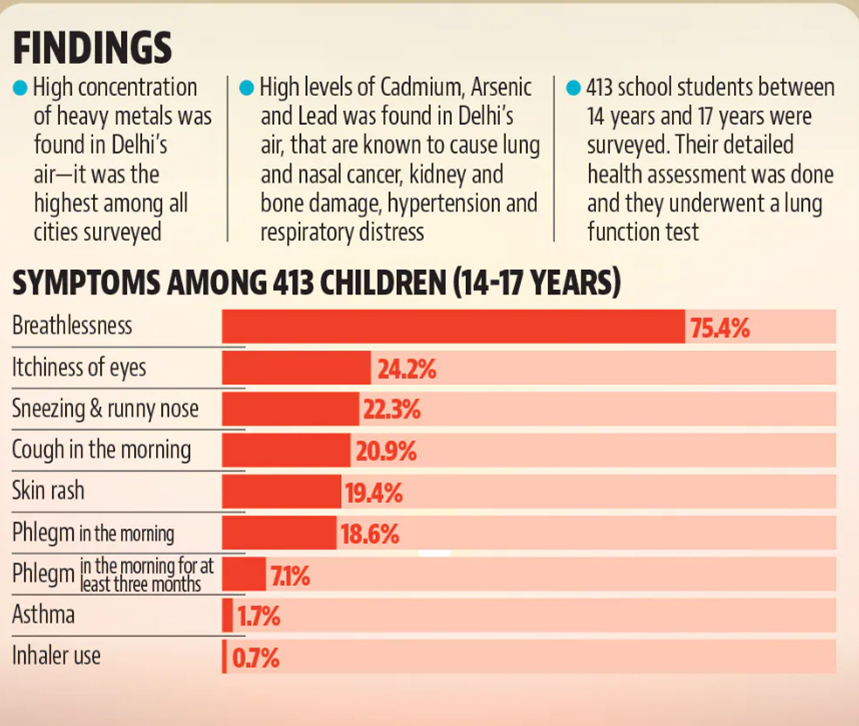Monday, 18th October 2021
Global Hunger Index (GHI) 2021
In News
India's position has dropped to 101 from 94 on Global Hunger Index 2021.
Highlights of the Report:
- India’s position: India has slipped to 101st position in the 2021 Index of 116 countries, from its 2020 position of 94th and is found to be behind Pakistan, Bangladesh and Nepal.
- Wasting: Wasting among children in India has increased from 17.1% between 1998 and 2002 to 17.3% between 2016 and 2020.
- The report noted that the covid-19 and the pandemic-related restrictions in India have severely hit the country with the highest child-wasting rate worldwide.

- Under-5 mortality rate: India showed improvement in indicators such as the under-5 mortality rate.
- Food Security and Other indicators: Food security was found to be under assault on multiple fronts along with other indicators like prevalence of stunting among children and undernourishment owing to inadequate food.
- Key Drivers of Hunger- the three Cs: Worsening Conflict, weather extremes associated with global Climate change, and the economic and health challenges associated with the Covid-19 pandemic were (three Cs) found to be the major reasons behind the prevailing conditions of hunger.
- Better off Neighbours: Nepal (76), Bangladesh (76), Myanmar (71) and Pakistan (92) were also in the ‘alarming’ hunger category but have fared better at feeding its citizens than India.
- Global Ranking: Eighteen countries, including China, Brazil and Kuwait, shared the top rank with GHI score of less than 5. India's GHI score has decelerated - from 38.8 in 2000 to 28.8 - 27.5 between 2012 and 2021.
- Negative Stride towards SDGs: Inequality between regions, countries, districts, and communities has been found pervasive and if left unchecked is expected to keep the world from achieving the Sustainable Development Goal (SDG) mandate to leave no one behind.
Global Hunger Index (GHI)
- The GHI is an annual report that measures and tracks hunger globally prepared and released by European NGOs of Concern Worldwide and Welthungerhilfe.
- The GHI score is calculated based on four indicators-
- Undernourishment
- Child wasting (the share of children under the age of five who are wasted i.e who have low weight for their height, reflecting acute undernutrition)
- Child stunting (children under the age of five who have low height for their age, reflecting chronic undernutrition) and
- Child mortality (the mortality rate of children under the age of five).
- For the 2021 report, data was assessed for 135
Sources:
- India Falls to 101 from 94 in Hunger Index Behind Pak, Nepal: Report
- India's position drops on Global Hunger Index 2021 to 101 from 94, WCD ministry says ranking unscientific
- Global Hunger Index
Image Source:
NASA’s Lucy spacecraft to study Trojans Asteroids
In News
NASA has launched the Lucy spacecraft, the first space mission to study the Trojans Asteroids.
About the News
- About the Mission: The solar-powered mission is estimated to be over 12 years long, during the course of which the spacecraft will visit eight asteroids covering a distance of about 6.3 billion km to deepen the understanding of our solar system.
- Naming of the mission: The mission is named after ‘Lucy’, a 3.2 million-year-old ancestor who belonged to a species of hominins (which include humans and their ancestors).
- Aim of the mission: It aims to study planet formation and evolution models. The mission is designed to understand the composition of the diverse asteroids that are a part of the Trojan asteroid swarms, to determine the mass and densities of the materials.
- Significance: Lucy will give us insights into the dynamical and physical processes that affected these planetary building blocks and will help us untangle the Solar System’s early history at the time when planet formation was ending, and the planets were moving into the orbital Configuration we see today.

About the Trojan asteroids
- Asteroids sharing an orbit with a planet, but which are located at the leading (L4) and trailing (L5) Lagrangian points, are known as Trojan asteroids.
- Although Trojan asteroids have been discovered for Mars and Neptune and even Earth, the term ‘Trojan asteroid’ generally refers to the asteroids accompanying Jupiter.
- The Jupiter Trojan asteroids are leftover raw materials from the formation of our Solar System’s giant planets (Jupiter, Saturn, Uranus, and Neptune) over 4 .5 billion years ago.
- They hold a record of the composition and physical conditions in the protoplanetary disk from which all the Sun’s planets, including Earth, formed.
Sources:
Repurposing of Ivermectin
In News
Ivermectin drug, which has been a game-changer for people with certain infectious diseases, has not been able to save patients from COVID-19 infection.
Ivermectin and Covid-19
- Repurposing of Drug: At the start of the pandemic, scientists and doctors tried to find inexpensive medications to repurpose for the treatment and prevention of Covid-19. Ivermectin was one such drug.
- The false hope around using ivermectin to treat Covid-19 originated from an April 2020 laboratory study in Australia.
- Toxic for Human: High doses of ivermectin used in these tests were found to be toxic for humans.
- The World Health Organization has unanimously recommended against the use of ivermectin to prevent or treat Covid-19 unless in the context of a clinical trial.
What is Repurposing of drug?
- Meaning: Infectious disease researchers frequently attempt to use antimicrobials and other medications already approved for one disease to treat other infections.
- Why repurposing: Drug repurposing is attractive because the approval process can happen more quickly and at a lower cost since nearly all of the basic research has already been completed.
- Caution: Not every attempt at repurposing a drug works as hoped, however.
About Ivermectin
- About: Ivermectin is an over 30-year-old wonder drug that treats life- and sight-threatening parasitic infections.
- Origins: It was first identified in the 1970s during a veterinary drug screening project and was approved in 1981 for commercial use in veterinary medicine for parasitic infections in livestock and domestic pets.
- Diseases Prevented: Thanks to ivermectin, river blindness has been essentially eliminated in 11 Latin American countries, preventing approximately 600,000 cases of blindness.
- Nobel Prize, 2015: William Campbell and Satoshi Omura were awarded the 2015 Nobel Prize in Physiology or Medicine, for their research in Ivermectin.
Sources:
Global Multidimensional Poverty Index, 2021
In News
The Global Multidimensional Poverty Index (MPI) 2021: Unmasking disparities by ethnicity, caste and gender, has been recently released.
What is Global MPI?
- About MPI, 2021: Using the data that are available, the 2021 report presents for the first time disaggregations by the gender of the household head for 108 countries, and by ethnicity or race or caste for 41 countries.
- Dimensions of MPI: The global Multidimensional Poverty Index (MPI) measures acute multidimensional poverty by measuring each person’s deprivations across 10 indicators in three equally weighted dimensions: health, education and standard of living.
- By identifying both who is poor and how they are poor, the global MPI complements the international $1.90 a day poverty rate.

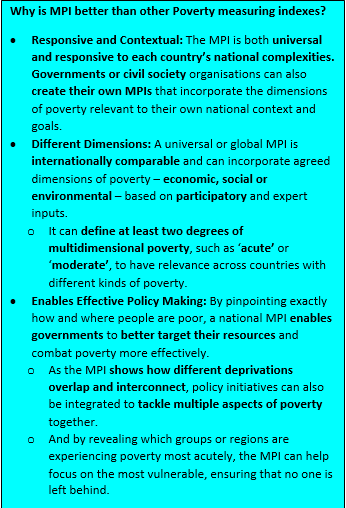
- Organizations: Launched in 2010 by the Oxford Poverty and Human Development Initiative at the University of Oxford and the Human Development Report Office of the United Nations Development Programme, the global MPI is updated annually to incorporate newly released surveys and share fresh analyses.
- Measurement: In the global MPI, people are counted as multidimensionally poor if they are deprived in one-third or more of 10 indicators.
- The MPI ranges from 0 to 1, and higher values imply higher multidimensional poverty.
Findings of the MPI, 2021

What does the MPI, 2021 reflect about India?
- Poverty widespread among STs, SCs: More than a quarter (27.9%) of Indians live in multidimensional poverty, but the poor are predominantly from schedules tribes and scheduled castes.
- Half of the STs, and a third of the SCs are multidimensionally poor, as against 27.2% OBCs and 15.6% of the unreserved population group.
- However, poor people in all these groups have roughly similar living conditions as they are deprived to a nearly similar degree.
- Large Population at risk: Apart from the 27.9% Indian population living in multidimensional poverty, another 19.3% is under the vulnerable category. As these surveys were done before the pandemic, the proportion of multidimensional poverty might have increased.
- Unfortunately, children who had to drop out of school because of lockdowns and economic stress would be the largest contributor to this increase.
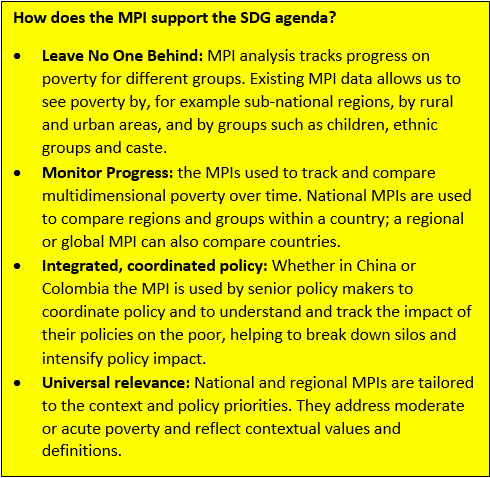
- Hunger is the biggest Challenge: Government schemes have improved India’s performance on some measures, such as infant mortality, school enrolment and electrification, but hunger remains at the top of the 10 measures of deprivation in India.
- Lack of food leads to wasting and stunting in children, negating the benefits of some other government efforts.
- Most poor in India: India now has 381 million people living in poverty – almost four times more than second-placed Nigeria (93 million). The poor across the Indian subcontinent lack nutrition, proper housing, and access to clean cooking fuel, and have high school dropout rates.
What are the main limitations of the MPI?
- Only Output Oriented: The indicators may not reflect capabilities but instead reflect outputs (such as years of schooling) or inputs (such as cooking fuel).
- Less Sensitive: To be considered multidimensionally poor, households must be deprived in at least six standard of living indicators or in three standard of living indicators and one health or education indicator, or in two health or education This requirement makes the MPI less sensitive to such assumption.
- Does not measure Inequality: While the MPI goes well beyond a headcount ratio to include the intensity of poverty, it does not measure inequality among the poor. Intra-household inequalities may be severe, but these could not be captured.
Way Forward
- Reach out to the most Vulnerable: Inequalities across ethnic groups remain prevalent in multiple countries. To reduce differences in poverty levels and rates, governments must focus on hard-to-reach groups, minorities and indigenous groups who are at risk of being left behind.
- Effective Data Collection: Another priority should be collecting better and more frequent data on ethnicity and group-based deprivations in order to enable efficient monitoring, reporting and targeting of poverty and inequalities across ethnic groups. Example: Socio-Economic Caste Census
- National Level Initiatives: The Niti Aayog has fast-tracked the development of India's own poverty index to rank states on measures they have adopted to pull people out of poverty. The exercise, in line with the MPI, is aimed at compelling states to take aggressive poverty reductions measures.
Question: Discuss the findings of the Global MPI, 2021. What do the findings reflect about India?
Sources:
This Day in History - Depressed Classes Mission Society of India
On October 18, 1906, the Depressed Classes Mission Society of India was established in Bombay by Mahrshi Vitthal Ramji Shinde for working against the evils of untouchability on the national level and restoring the respect and equality for all castes and classes. The mission aimed at getting rid of untouchability, providing educational facilities for untouchables, solving their social problems, and starting up schools, hostels, and hospitals for them. The mission set up several schools and hostels over the years. The mission even set up an ashram named Ahilya Ashram in Pune in 1922.
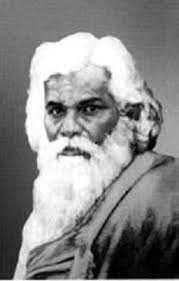
Source:
Image of the Day - Mars on Earth
This is image of Scientists participating in a demonstration of an experiment led by Austrian and Israeli agencies simulating a mission to Mars. In the Ramon Crater in the desert of southern Israel, a team of six - five men and one woman - have begun simulating what it will be like to live for about a month on the red planet. The landscape is rocky, hilly, tinged with red. Purposefully it resembles Mars. Their AMADEE-20 habitat is tucked beneath a rocky outcrop. Inside they sleep, eat and conduct experiments. Outside they wear mock space suits fitted with cameras, microphones and self-contained breathing systems.

Source:
Rafale Fighters
- Context: In a major boost for the Indian Air Force, three more Rafale fighter jets will be arriving in Gujarat's Jamnagar from France shortly.
- The three new fighter jets will increase the count of Rafale jets to 29 out of the total 36 that India had ordered as part of the ₹60,000 crore deal inked in 2016 with France.
- Rafale is a French twin-engineand multirole fighter aircraft designed and built by Dassault Aviation for both the French Air Force and the French Navy.
- It was introduced in 2001 and is equipped with a wide range of weapons to perform air supremacy, interdiction (act of disrupting), aerial reconnaissance (observation to locate an enemy), ground support, in-depth strike, anti-ship strike and nuclear deterrence missions.
- These jets have the ability to strike air-to-air targetsfrom up to 150 km away and safely hit land targets 300 km within enemy territory that make them one of the deadliest fighter jets in the world.
- The aircraft has 30,000 flight hours in operations.

Sources:
- Three more Rafale fighters arriving from France, to land in Gujarat's Jamnagar tonight
- 36 Rafale fighter jets fleet will be a game changer for India: Experts
- The Arrival of the Beauty and The Beast
Image Source:
Body Cameras for Surveillance
- Context: Prison authorities in Delhi have procured 375 body cameras for better surveillance in three prison complexes.
- The cameras will be given to warders deployed in the wards of 16 jails (every ward will be deployed with two or three such cameras).
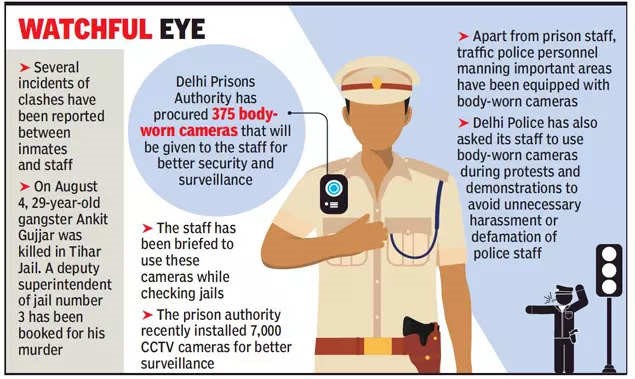
- The cameras have good resolution and have a recording system with battery backup of nearly seven hours.
- It will offer digital evidence in instances of abuse and attack of the prison staff by the prisoners as well as any manhandling of the prisoners by the prison staff thus maintaining transparency in jail supervision.
- They provide security at high-risk wards, important prison gates and during checks especially at jail complexes like Tihar that holds more than 12,000 prisoners.
Sources:
Import Duty on Edible Oil
- Context: The government has recently scrapped all import duties on edible oils till March 31, 2022 and has removed agri cess.
- The move aims to provide relief to consumers from the surge in global price of the commodity.
- The basic customs duty on crude palm oil, crude soya-bean oil and crude sunflower seed oil has been reduced.
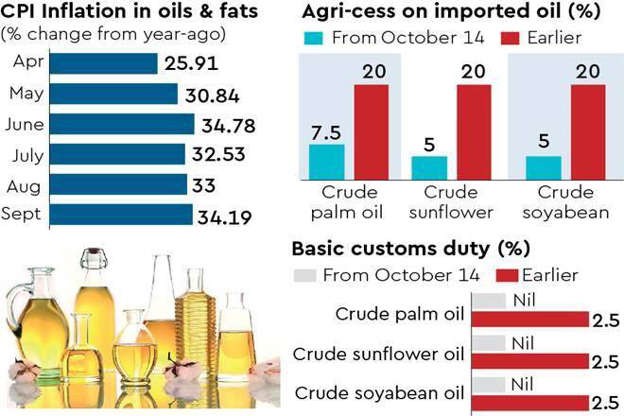
- Import duty is a tax collected on imports and some exports by a country's customs authorities.
- ‘Agriculture Infrastructure and Development Cess’ (AIDC), introduced in the 2021 budget, is a cess levied on specific imported and excisable goods specified in the first schedule of the Customs Tariff Act at a rate not exceeding the customs.
- The main purpose for levying AIDC is to finance agriculture infrastructure and other development expenditure, while also conserving and processing agricultural output efficiently.
Sources:
- Import duty slashed on edible oils
- Govt scraps import duty on edible oils until March 2022, removes agri cess
Image Source:
Cigarette smoking and SARS-CoV-2
- Context: While smoking is associated with increased severity of covid-19, some reports have suggested fewer covid cases among smokers.
- Cigarette smoke contains polycyclic aromatic hydrocarbons (PAHs) that can bind to and activate aryl hydrocarbon receptors (AHRs).
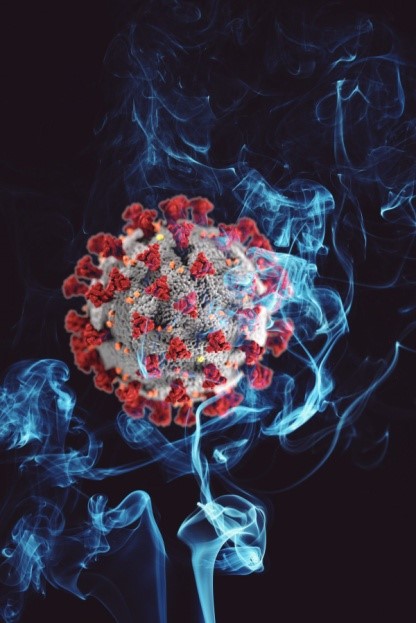
- AHRs are receptors inside mammalian cells that can induce a wide range of cellular activities.
- A receptor is a structure on the surface of a cell or inside it that is shaped to receive and bind to a particular substance.
- The effect of chemicals that activate AHR on the genes that control the production of the ACE2, the receptor protein on the surface of some cells that the SARS-CoV-2 virus can hook onto was studied.
- It was found that cells in the oral cavity, lungs and liver had the highest ACE2 expression.
- These cells were then subjected to various doses of cigarette smoke extract for 24 hours.
- It was found that the greater the dose of the cigarette-smoke extract on the cells, the more was the impact on the CYP1A1 gene expression (greater activity of the gene led to less production of the ACE2 proteins that the virus uses to enter cells) thus inhibiting or reducing the chances of infection.
Source:
Image Source:
The digital revolution in Indian health care: HT
Essence: The article discusses the Ayushman Bharat Digital Mission, which aims to help achieve Universal Health Care (UHC). Through the article, the author tries to explain universal healthcare. The mission uses the “public goods, private innovation” model so that high quality data is available for good public health policy and management. The Mission is voluntary and aims to do away with paper-based records which can enhance continuity of care as service providers can access a patient’s digital health record after patient’s consent. Some of the challenges in its implementation are identifying strong incentives and benefits for each stakeholder to voluntarily join, implementing safeguards that ensure privacy in the absence of data protection law and adoption of digital technology by small hospitals.
Why you should read this article?
- To understand about the concept of universal health care.
- To know about the aim of the Ayushman Bharat Digital Mission and its six guiding principles.
- To understand about the benefits and challenges in the implementation of this mission.
Source:
Coal India, the fall guy for power crisis: IE
Essence: In the context of Coal crisis, Coal India Ltd (CIL) has been unfairly criticized, despite it having played a crucial role in the crisis. Structurally, CIL cannot meet the demand of the power sector in case the pace of capacity addition accelerates and operationally, non-payment of dues by power plants has created a strain on the working capital position of coal companies.
The second wave of the pandemic and the extended monsoon have aggravated the crisis. The post-Covid economic recovery and an increase in imported coal prices have further increased the demand for domestic coal. Even after bearing the highest tax and transport cost globally, the cost of CIL coal is cheaper benefiting in savings of foreign exchange and affordable power tariffs.
Why you should read this article?
- To understand the reasons for Coal crisis.
- To know about the significance of Coal India Limited.
Source:
Gender equality: Why we must involve men: HT
Essence: Rise in complaints of abuse from women because of unemployment, food insecurity, and spousal substance abuse shows that violence against women cannot be tackled unless men are involved in the efforts. There are several men organisations in India who are working on to ensure more equitable gender relations by changing the mindsets of boys and men. Article further suggests that all stakeholders (family, teachers, involvement of men’s group through Panchayati Raj Systems) should come forward to tackle this issue. Besides, we need to open more communication channels to boys and men in ending violence against women and needs to replicate such efforts on a much larger scale.
Why should you read this article?
- To get an overview of an issue, “violence against women” and reasons associated with.
- To understand what possible steps can be taken to tackle the same.
Source:
Japanese Miyawaki in Rajasthan
Background
- Uncontrolled tree cutting and forest exploitation has resulted in forest devastation and disturbance to wildlife habitat.
- Bhuvnesh Ojha of Rajasthan understood the crucial role of forests in maintaining the ecosystem and tried to restore the forests through plantation drives.
- Miyawaki: The forest growing technique involves planting native plant species in density that enables speedy growth within two to three years.
How Japanese Miyawaki was implemented in Rajasthan?
- Initial steps: Plantation of trees were carried out around the government land and publicly available spaces.
- Effective Social media use: The message of tree plantation were circulated through videos and images of live plantations on social media platforms.
- Finances: Financial resources are pooled in for the seeds and other inputs from NGOs.
- Maintenance: The volunteers gather every Sunday and dedicated hours for the maintenance and upkeep of the saplings.
- Horticulture: Better cost effective plants especially fruit bearing ones are cultivated to support the farmers in longer duration.
- Implementing Government Schemes: Farmers were motivated to take up water conservation works under Mahatma Gandhi National Rural Employment Guarantee Act (MNREGA) by digging trenches.
- Better environment: The mini forest near the village act as micro-climate zone and provide cool air in the vicinity. Bhuvnesh and thousands of volunteers have planted eight dense Miyawaki forests in and around Udaipur.
- Keeping count: The planted saplings are documented and geotagged with the coordinates for better monitoring.
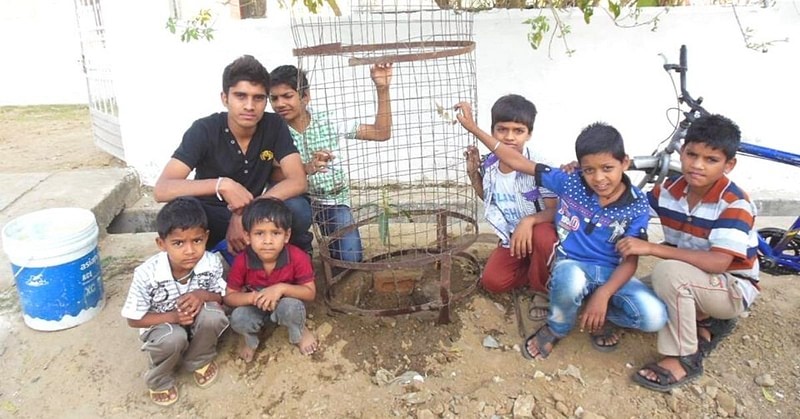
Quote: “A reasonable agriculture would do its best to emulate nature. Rather than change the earth to suit a crop it would diversify its crops to suit the earth.”- Verlyn Klinkenborg.
Source:
Share the article
Get Latest Updates on Offers, Event dates, and free Mentorship sessions.

Get in touch with our Expert Academic Counsellors 👋
FAQs
UPSC Daily Current Affairs focuses on learning current events on a daily basis. An aspirant needs to study regular and updated information about current events, news, and relevant topics that are important for UPSC aspirants. It covers national and international affairs, government policies, socio-economic issues, science and technology advancements, and more.
UPSC Daily Current Affairs provides aspirants with a concise and comprehensive overview of the latest happenings and developments across various fields. It helps aspirants stay updated with current affairs and provides them with valuable insights and analysis, which are essential for answering questions in the UPSC examinations. It enhances their knowledge, analytical skills, and ability to connect current affairs with the UPSC syllabus.
UPSC Daily Current Affairs covers a wide range of topics, including politics, economics, science and technology, environment, social issues, governance, international relations, and more. It offers news summaries, in-depth analyses, editorials, opinion pieces, and relevant study materials. It also provides practice questions and quizzes to help aspirants test their understanding of current affairs.
Edukemy's UPSC Daily Current Affairs can be accessed through:
- UPSC Daily Current Affairs can be accessed through Current Affairs tab at the top of the Main Page of Edukemy.
- Edukemy Mobile app: The Daily Current Affairs can also be access through Edukemy Mobile App.
- Social media: Follow Edukemy’s official social media accounts or pages that provide UPSC Daily Current Affairs updates, including Facebook, Twitter, or Telegram channels.

